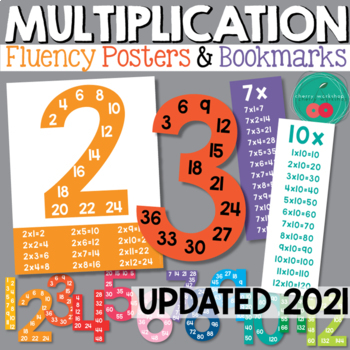Multiplication Number Posters, Multiples Posters, Skip Counting Posters
Cherry Workshop
8.1k Followers
Grade Levels
2nd - 4th
Resource Type
Standards
CCSS3.OA.A.1
CCSS3.OA.A.4
CCSS3.OA.D.9
CCSS4.OA.B.4
Formats Included
- PDF
Pages
90 pages
Cherry Workshop
8.1k Followers
What educators are saying
My students used this resource over and over while learning two digit multiplication and long division
My students used these posters ALL THE TIME. In fact, when I had to cover them for PSSA testing I saw them trying to "look" at the wall in the room where they knew they could get the answers.
Description
Multiples Posters, Multiples Skip Counting Posters, Multiplication Posters in bright and beautiful colors
This resource has been recently (2021 ) updated after feedback I've received. Now it includes a black font version as well as reverse multiples version.
WHAT IS INCLUDED
- Posters with numbers and multiples
- Posters with numbers with multiples and multiplication facts
- Posters with numbers with multiples and multiplication facts - multiples in reverese order
- All of the above with black font
- Bookmarks in several styles
A total of 90 pages. You would most likely not need them all but you have the option to choose the ones that suit your needs best.
SUGGESTED USE
You may choose the use the posters with the backgrounds or cut out the numbers alone.
Also these can always be printed smaller and used as flashcards or at centers.
YOU MAY ALSO LIKE
Halloween Interactive Notebook Foldable Multiplication Strategies
Happy Teaching!
Total Pages
90 pages
Answer Key
N/A
Teaching Duration
N/A
Report this resource to TPT
Reported resources will be reviewed by our team. Report this resource to let us know if this resource violates TPT’s content guidelines.
Standards
to see state-specific standards (only available in the US).
CCSS3.OA.A.1
Interpret products of whole numbers, e.g., interpret 5 × 7 as the total number of objects in 5 groups of 7 objects each. For example, describe a context in which a total number of objects can be expressed as 5 × 7.
CCSS3.OA.A.4
Determine the unknown whole number in a multiplication or division equation relating three whole numbers. For example, determine the unknown number that makes the equation true in each of the equations 8 × ? = 48, 5 = __ ÷ 3, 6 × 6 = ?.
CCSS3.OA.D.9
Identify arithmetic patterns (including patterns in the addition table or multiplication table), and explain them using properties of operations. For example, observe that 4 times a number is always even, and explain why 4 times a number can be decomposed into two equal addends.
CCSS4.OA.B.4
Find all factor pairs for a whole number in the range 1-100. Recognize that a whole number is a multiple of each of its factors. Determine whether a given whole number in the range 1-100 is a multiple of a given one-digit number. Determine whether a given whole number in the range 1-100 is prime or composite.





